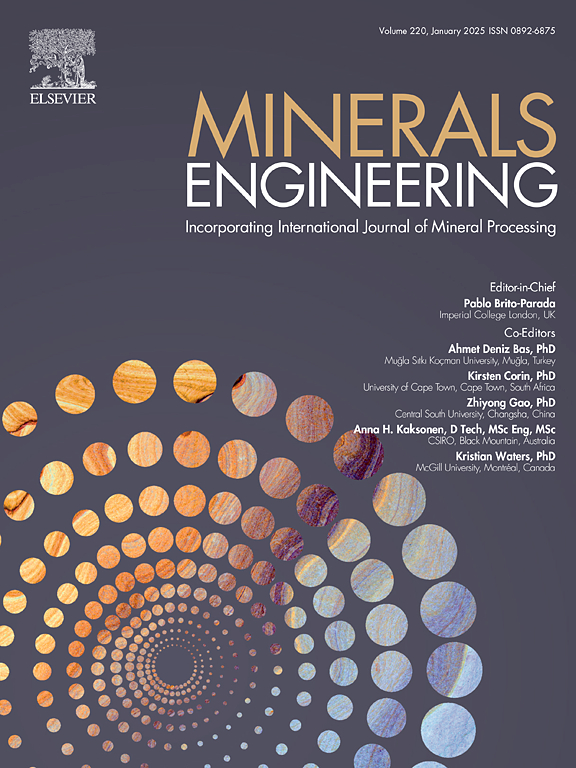Study on the mechanism of the effect of plasma modified APAM on the sedimentation of kaolinite particles
IF 4.9
2区 工程技术
Q1 ENGINEERING, CHEMICAL
引用次数: 0
Abstract
In coal slime water treatment, traditional anionic polyacrylamide (APAM) faces challenges including difficulties in balancing charge density with hydrolysis degree and inadequate hydrophilicity. This study developed a plasma-modified APAM (P-APAM) and systematically investigated its enhancement mechanism for kaolinite particle flocculation and sedimentation. Experiments were performed with 5–20 s plasma treatments on APAM solutions, analyzing P-APAM properties such as viscosity, pH, conductivity, molecular chain structure, and functional group configuration. Parallel flocculation-sedimentation tests evaluated kaolinite treatment performance through settling velocity, supernatant turbidity, floc size, and Zeta potential measurements. Results revealed that 5 s plasma treatment strengthened hydrogen bonding while altering oxygen-containing functional group composition and arrangement in P-APAM molecules. The treatment promoted oxidative degradation of hydrophobic groups (–CH3/–CH2-), boosting hydration capacity and hydrophilicity while optimizing molecular chain flexibility and surface adaptability. The modified P-APAM formed compact floc structures (SK value = 0.612), achieving superior sedimentation rates, larger floc sizes, and enhanced flocculation efficiency at reduced dosages. Comprehensive experimental analysis confirmed that plasma-modified P-APAM substantially improved kaolinite flocculation and sedimentation performance. This research presents an innovative plasma-modified flocculant approach for clay mineral treatment in slime water, establishing an effective technical pathway for developing high-performance green flocculant systems with significant reference value for sustainable mineral processing.
等离子体改性APAM对高岭石颗粒沉降影响的机理研究
在煤泥水处理中,传统阴离子聚丙烯酰胺(APAM)面临着电荷密度与水解度难以平衡、亲水性不足等挑战。本研究研制了等离子体修饰的APAM (P-APAM),并系统研究了其对高岭石颗粒絮凝沉降的增强机理。实验对APAM溶液进行5-20 s等离子体处理,分析P-APAM的粘度、pH、电导率、分子链结构和官能团构型等特性。平行絮凝沉降试验通过沉降速度、上清浊度、絮团大小和Zeta电位测量来评估高岭石处理性能。结果表明,5s等离子体处理增强了P-APAM分子中的氢键,改变了P-APAM分子中含氧官能团的组成和排列。该处理促进了疏水基团(- ch3 / - ch2 -)的氧化降解,提高了水合能力和亲水性,同时优化了分子链的柔韧性和表面适应性。改性后的P-APAM形成了致密的絮凝体结构(SK值= 0.612),在降低投加量的情况下,获得了更好的沉降速度、更大的絮凝体尺寸和更高的絮凝效率。综合实验分析证实,等离子体修饰的P-APAM显著改善了高岭石的絮凝沉降性能。本研究提出了一种创新的等离子体改性絮凝剂处理泥水中粘土矿物的方法,为开发高性能绿色絮凝剂体系建立了有效的技术途径,对矿物的可持续处理具有重要的参考价值。
本文章由计算机程序翻译,如有差异,请以英文原文为准。
求助全文
约1分钟内获得全文
求助全文
来源期刊

Minerals Engineering
工程技术-工程:化工
CiteScore
8.70
自引率
18.80%
发文量
519
审稿时长
81 days
期刊介绍:
The purpose of the journal is to provide for the rapid publication of topical papers featuring the latest developments in the allied fields of mineral processing and extractive metallurgy. Its wide ranging coverage of research and practical (operating) topics includes physical separation methods, such as comminution, flotation concentration and dewatering, chemical methods such as bio-, hydro-, and electro-metallurgy, analytical techniques, process control, simulation and instrumentation, and mineralogical aspects of processing. Environmental issues, particularly those pertaining to sustainable development, will also be strongly covered.
 求助内容:
求助内容: 应助结果提醒方式:
应助结果提醒方式:


